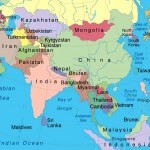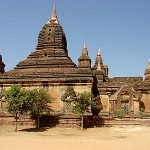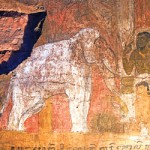
Hema Goonatilake PhD (Lond)
Visiting Professor, Royal University of Phnom Penh, Cambodia
Published in the Journal of the Royal Asiatic Society of Sri Lanka, New Series, Vol. LIII, 2008
The development of Sinhalese-Lao relations is tied to Sinhalese relations with the broad South-east Asian region, immediately prior to the establishment of the Lao kingdom. It is therefore useful to survey the political and religious situation in the region, with special emphasis on their relations with Sri Lanka.
Sri LankaÔÇÖs relations with Northern South-east Asia – Myanmar
By the 11th century, Sri Lanka had established close ties with Myanmar. The Culavamsa records that King Vijayabahu I (1065-1120 C.E.) requested assistance from King Anawratha ÔÇô Pali Anuruddha – (1044-1077 C.E.), to defeat the Colas (Cv., LX., vv. 5-6). Vijayabahu had also sent a religious mission, requesting for Bhikkhus to restore the Sangha in Sri Lanka which had by then deteriorated. Hence, with the help of twenty senior Bhikkhus who arrived from Ramanna country (Lower Myanmar), the upasampada was re-established in Sri Lanka. According to Burmese chronicles, at the request of Anawratha, Vijayabahu also sent a duplicate of the Tooth Relic to the Burmese king. The latter, after making more duplicates, enshrined it in the Shwezigon Pagoda (Glass Palace Chronicle GPC, pp. 88-92). The subsequent King Kyanzitta (1084-1113 C.E.) revised the Tripitaka, based on the

Sinhala version (3rd
Swehsandaw Inscription, Epigra. Birm. I, part II, p.163). Luce noted that there would have been at the time, a large number of Sinhala Bhikkhus in Myanmar to carry out the task of teaching Pali through the Sinhala script and help translate the texts on a large scale from Pali into Mon initially, and later into Burmese. (Luce, BBHC Vol II 1961, pp. 277-416). The Mon dominance over scholarship in Myanmar until then, was thus soon replaced by Sinhala Theravada.
Because of such close links, Sri Lanka became a place of refuge even for the Sangharaja Panthagu of Myanmar, when after a political crisis, he came over to Sri Lanka in 1167 and stayed for six years (GPC p. 133). In 1170, Sangharaja Uttarajiva visited Sri Lanka on pilgrimage along with a team of monks including the Mon samanera named Chapata and Tamalinda, the latter identified as the son of the Cambodian king, Jayavaraman VII (1181-1219 C.E.) (Coedes, 1968, p. 178). The team after receiving upasampada, and studying Tripitaka for ten years returned to Myanmar to form a new sect, the ÔÇ£Sihala SanghaÔÇØ under royal patronage which became the most influential sect in Myanmar. Close ties between the two countries continued. And as recorded in the Kalyani Inscriptions, a team of 22 senior monks sent by King Dhammazedi (1472-92 C.E.) received upasampada ordination on the Kalyani river in Sri Lanka in 1476. This was under the leadership of Mahathera Vidagama during the reign of Buvanekabahu VI. On their return, the entire Burmese Sangha – a total of 15,666 Bhikkhus were re-ordained in the Sinhala form of ordination (Kalyani Sima, p. 8).
In the subsequent centuries, religious thought, art, architecture and literature of Myanmar were all influenced by the Sinhala form of Theravada. Mahayana as well as Hindu elements, especially noted in iconography were  soon absorbed to suit current Theravada tastes, the earlier traditions often becoming merely decorative in the process (Strachan,┬á 1988, pp. 10, 87). Around this time, KyanzitthaÔÇÖs son Rajakumar also painted on Myinkaba Kubyauk-gyi temple with illustrations of the Mahavamsa. (Personal observations of the walls of the Myinkaba Kubyauk-gyi temple. See also Goonatilake, 2006, pp. 74-77).
soon absorbed to suit current Theravada tastes, the earlier traditions often becoming merely decorative in the process (Strachan,┬á 1988, pp. 10, 87). Around this time, KyanzitthaÔÇÖs son Rajakumar also painted on Myinkaba Kubyauk-gyi temple with illustrations of the Mahavamsa. (Personal observations of the walls of the Myinkaba Kubyauk-gyi temple. See also Goonatilake, 2006, pp. 74-77).
The tradition of chronicle writing in Myanmar began – directly modelled after the Mahavamsa. The oldest chronicle Mahasammatavamsa ÔÇô in Burmese Ya-zawin-gyaw – written in 1520 C.E., is a continuation of the Mahavamsa with six-seventh of the space allotted to the early sections of the Mahavamsa. The remainder contains a list of Burmese kings and their works of merit. The subsequent chronicles, Maha-ya-Zawin-gy, written in 1730, Hman-nan ya-zawin (The Glass Palace Chronicle), written in 1821 too were all modelled after the Mahavamsa (Hla Pe, 1985, pp. 52-67).
Sri LankaÔÇÖs relations with Northern Thailand
As in Myanmar, the kings of what is today Northern Thailand, such as King Lodaiya (or Loethai) (1317-1347 C.E.) of Sukhothai and King Kilana (or Kuena) (1355-1385 C.E.) of Nabbisapura (present-day Chiangmai), too were keen on receiving the Sri Lankan form of upasampada. This is evident from their initiative in requesting the Udumbara Mahasami from Udumbaragiri (present day Dimbulagala) forest fraternity in Sri Lanka, who was resident in Martaban in lower Myanmar (present-day Muttima) to send a monk who would perform upasampada. Udumbara Mahasami has been identified as Sangharaja Medhankara, the author of the Lokappadipakasara (UCHC, Vol. I, pt. II p. 754). Udumbara Mahasami sent Thera Sumana from Sukhothai, who had received upasampada under him in Martaban. Under the patronage of the kings, Thera Sumana established the Sihala Sangha sect in the regions of Sukhothai, Chiangmai and in Haripunjaya (modern Lamphun).
Thera Sumana’s arrival in northern Thailand, not only led to the consolidation of the Sinhala Upasampada, but also to the setting up of a large number of Buddhist monuments and sculpture in that region (Jinakalamali, p. xxiii). This information given in the Jinakalamali is confirmed by a stone inscription in Pali and Thai at Wat Phra Yun (a monastery built by King Kilana) in Haripunjaya (Nagara & Griswold, 1992 pp. 605-624). King Kilana also built an artificial cave, Wat Umong in Chiang Mai to house visiting Sinhala Bhikkhus (Goonatilake, 2003 b p. 295).
King Luthai (1347-1361) became a great patron of the Sinhala Sangha in Sukhothai, and made Sukhothai a centre of Theravada Buddhist activities in Thailand. Several inscriptions from the second half of the 14th century (Griswold and Prasert, 1968, 1969, 1971, 1978) give evidence of the strong direct religious contacts between the king of Sukhothai and Sri Lankan Bhikkhus. Two inscriptions among these, in
Thai and Khmer dated 1361 C.E. were especially composed to commemorate the arrival in Sukhothai of a learned Sangharaja from Sri Lanka who was residing at the time in Martaban. King Luthai studied under him, and received ordination from the Sangharaja.
Si Satha (Sri Sraddha), a prince monk from Sukhothai spent ten years in Sri Lanka learning the Dhamma and visiting the major Buddhist sites, and returned around 1345 along with several craftsmen from Gampola. He got the Sri Lankan craftsmen settled in five villages in Sukhothai, and through them added Sinhala style stucco motifs of makaras, to the Mahathat stupa, the centre piece of Sukhothai. These motifs were based on GampolaÔÇÖs Lankatilaka temple, which had been built in 1342 during Si SathaÔÇÖs stay in Sri Lanka. The bell-shaped stupas which began to be built in large numbers in the middle of the 14th century in Sukhothai, and the standing elephants emerging from niches found in Sukhothai were also inspired by the Gampola Lankatilaka and Gadaladeniya temples, two sites visited by Si Satha. Sukhothai architecture was thus transformed with “overwhelming adoption of Sinhalese styles ÔǪa multitude of Sinhalese-style stupas” (Gosling 1998, p. 121, p 123, Goonatilake, 2001 b).
The famous Pali work Saddhammasangaha, a history of Buddhism in Sri Lanka, was composed by a Thai monk who returned to Ayudhya after studying and receiving upasampada as Dhammakitti under the Sangharaja Dhammakitti Mahasami of Gadaladeni. On return to Ayudhya, this Thai Mahathera Dhammakitti stayed at Lankarama, a monastery named after Sri Lanka, built by Boromaraja (Paramaraja) (1370-1388 C.E.). Sangharaja Dhammakitti has been identified as Dhammakitti who held the office of Sangharaja in the reign of Bhuvanaikabahu V (1372-1408 C.E.).
According to the Lanna Chronicles (again like all Southeast Asian chronicles, Lanna chronicles too had been inspired by the Mahavamsa), King Tilokaraja (1448-88 C.E.) had in 1455, planted a Bodhi branch brought from Anuradhapura, and built a monastery in Chiang Mai. This monastery had come to be known as Wat Sihalaram (Sihala Aramaya) or Wat Mahabodharam (Maha Bodhi Aramaya) (today known as Wat Cedi Cet Yod). King Tilokaraja became a great patron of the Lankavamsa or Sihala (Sihon in Thai) sect, and had invited Mthangkon, a Sinhala monk from Lamphun to spend the rains retreat at Ratchamonthian Temple and given him the title Phra Maha Swami. The king himself who was temporarily ordained patronised the Sihala school which emphasised the study of Pali and proper Vinaya. Wat Sihalaram thus became the first centre of Pali studies in Thailand.┬á This king convened the Eighth World Tripitaka Council, held in 1477 for one year at Wat Sihalaram (Ongsakul, p. 80). It is also mentioned that by the order of the king, the king’s general named Sihalagotta (Sinhala clan) rebuilt the shrine called Rajakuta in Chiangmai, and deposited a sacred relic, brought from Sri Lanka. It is likely from his name that this general Sihalagotta was a Sinhalese, and therefore had been assigned this task.
Sri LankaÔÇÖs relations with Southern South-east Asia – Nakhon Si Thammarat and Cambodia
The earliest presence of the Sinhala form of Buddhism in the region of the present Thailand was found in its south at Siridhammanagara (or Nagara Sri Dhammaraja) or Ligor, (present-day Nakhon Si Thammarat) in the Thai-Malay peninsula.  Dupont noted that a number of Buddha images discovered in the Chaiya (Jaiya) region in Nakhon Si Thammarat belongs to the period between 8th and 12th centuries, and that the major influence on this Chaiya school of sculpture was Sinhalese (Dupont 1942). This observation is confirmed by recent research showing that Phra Boromathat Ceti (Great Relic Ceti), the first Sinhala style stupa, modelled after Kirivehera in Polonnaruwa and six other Sinhala style stupas built around the same time in the peninsula were inspired by the Sinhala Bhikkhus who travelled there. This was after the flourishing state of Buddhism in Sri Lanka brought about around 1165 A. C. by Parakramabahu I (1153-1186 A. C.) (Noonsuk and Noonsuk, 2001).
It has been pointed out that the Sinhalese Lankavamsa ordination arrived at Angkor in Cambodia about this same time through Nakhon Si Thammarat, and found a foothold during the reign of the Cambodian King Jayavarman VII (1181-1219 C.E.). From the Cambodian capital, Angkor, the Lankavamsa spread north and west into what is now Thailand and Laos. The same stupa style of Kiri Vehera inspired the stone stupa in the temple Prasat Phra Khan, built by Jayavarman VII in honour of his dead father. This spread of Sinhala cultural influence was tied with Angkor prestige, its script and the cult of divine kingship as Cambodia was then the dominant power in the region. As a major evidence for this, is the fact that the Pali language was consistently written in the Khmer script in the region for a long period of time (Michael Wickery, Conference Proceedings, 2001, Goonatilake, 2003 a, pp. 191-211).
There had been earlier references to Sri Lanka-Cambodia contacts including those relating to marriage and trade alliances. The 12th century Burmese king [King Alaungsithu 1112-1167 C.E.], in suspecting Sri Lankan envoys to Cambodia of consolidating contacts with the King of Cambodia, captured the envoys and confiscated their elephants, brought for trade with Cambodia. On a second occasion, a Sinhalese princess was captured (Cv, LXXVI, 21, 22, 35).┬á In retaliation to the Burmese king’s action, a raid on some of the ports of Myanmar was carried out by King Parakramabahu I (Devanagala inscription, EZ, Vol III, No 34, pp. 312). Sri Lankan monks now intervened between the two fellow Buddhist countries, Sri Lanka and Myanmar, and good relations between the two countries were resumed (Cv, LXXVI, 10-75).
The king of Sri Lanka was here, apparently responding to a request made by the Cambodian king Dharanindravarman II (who was a Buddhist) by sending a princess as a bride to his son Jayavaraman VII (Sirisena 1978, pp. 22-35). Luce (1969) has argued that the rulers of South-east Asian countries, especially the Cambodian and Burmese kings were eager to have consorts from Sri Lanka, probably because the people of these countries regarded Sri Lanka as the Holy Land of Buddhism. According to the Glass Palace Chronicle of the Kings of Burma (p. 114), the Burmese king Alaungsitthu (1112-1167) visited Sri Lanka, married the Sri Lanka kingÔÇÖs daughter, and returned to Myanmar. This episode is not mentioned in Sri Lankan sources.
The continuation of Sri LankaÔÇÖs relations with Nagara Sri Dhammaraja during the reign of Parakramabahu II (1236-1270 A. C.) of Dambadeniya, is found in both Sri Lankan as well as Thai sources. Parakramabahu II sent two missions to foreign lands to get monks with a view to re-organising the sangha in Sri Lanka, one to the Cola kingdom and the other to Tambarattha (Culavamsa, 84, 9-16). The Hatthavanagalla-vihara-vamsa refers to an invader called Candrabhanu from Tambalingu3 who raided Sri Lanka during the same time. A Sanskrit inscription of Chaiya (Jaiya) in the Thai-Malay peninsula dated 1230 C.E., describes Candrabhanu who invaded Sri Lanka as the king of Tambralinga (Coedes, 1948, p. 72). Sirisena has established that Candrabhanu, after failing to gain some relics from Sri Lanka by force, succeeded in getting them by peaceful means in association with the ruler of Sukhothai (Sirisena, 1978, pp. 46, 88).
Thai chronicles, the Jinakalamali (1516 C.E.) and the Sihinga Buddharupanidana (the latter ÔÇô ÔÇÿDescription of the Sinhalese Buddha ImageÔÇÖ) refer to a joint mission sent to Sri Lanka by Rocaraja (identified as King Rama Khamheng (1279-1298 A.C) of the first Thai kingdom Sukhothai, and the king of Nagara Sri Dhammaraja. This was to request the king of Sri Lanka to send the Sihinga Buddha image made in Sri Lanka.
3 Tambarattha and Tambalingu have been identified as Nagara Sri Dhammaraja.
Sinhalese Influence on Laos: From its Beginning to Consolidation ÔÇô Part I ÔÇô Sources
References
Briggs, L.P., The Ancient Khmer Empire, The American Philosophical Society, Philadelphia, 1951
Coedes, George, ‘Documents sur 1’histoire politique et religiouse du Laos accidental’, Bulletin de lÔÇÖEcole Francaise dÔÇÖExtreme Orient, (BEFEO) XXV, 1925.
Coedes, George, The Indianized States of Southeast Asia, East-West Center Press, Honolulu, 1967.
Culavamsa, ed. W. Geiger, 2 vols., London 1925, 1927.
Tr. W. Geiger, translated from the German into English by C. M. Rickmers. Pts. I and II, New Delhi 1992.
Damrong, Prince, ÔÇ£Siamese History prior to the Founding of Ayuthaya.ÔÇØ Jornal of Siam Society, 13 (2), pp. 1-66, 1919.
Epihraphia Birmanica being Lithic and Other Inscriptions of Burma, ed. Chas. Duroiselle, Rangoon, 1928.
Finot, Louis, Recherches sur la Litterature Laotienne, Bulletin de lÔÇÖEcole Francaise dÔÇÖExtreme Orient, XVII No. 5, Hanoi, 1917.
Glass Palace Chronicle of the Kings of Burma, Tr. Pe Muang Tin and G. H. Luce,  Myanmar Research Society, Rangoon, 1960.
Goonatilake, Hema & Kim Van, The Story of Prabang: A Sri Lankan Buddha Image in Laos, (Translation) Unpublished, 1998).
Goonatilake, Hema, ÔÇ£Rediscovering Cambodian Buddhist Women of the PastÔÇØ, Innovative Buddhist Women: Swimming against the Stream, ed. Karma Lekshe Tsomo, Curson Press, Surrey, 2000.
Goonatilake, Hema, ÔÇ£LaosÔÇØ, Buddhist Encyclopaedia, Colombo, 2001 a.
Goonatilake, Hema, Paper presented at Conference on ÔÇÿCultural Exchanges between Thailand and Sri LankaÔÇÖ, Nakhorn Sri Thammarat, October 2001 b.
Goonatilake, Hema, ÔÇÿSri Lanka-Cambodia Relations with Special Reference to the Period 14th – 20th CenturiesÔÇÖ, Journal of the Royal Asiatic Society of Sri Lanka,┬á New Series Vol. XLVIII, Special Number ÔÇô Commemoration of the 250th Anniversary of Upasampada in Sri LankaÔÇÖ, 2003 a.
Goonatilake, Hema, ÔÇ£Founders of a New Civilisation: Sinhala Bhikkhus in South-East AsiaÔÇØ, Symposium on Buddhist Studies, Thames Meditation Society U.K., 2003 b.
Goonatilake, Hema, ÔÇÿThe 12th Century Paintings of the Mahavamsa in BurmaÔÇÖ, Sri Lanka Puravidya Samhita, Vol. 2, Archaeology Society of Sri Lanka, Colombo, 2006.
Gosling, Betty, Old Luang Prabang, Kuala Lumpur, OUP, 1996.
Gosling, Betty, A Chronology of Religious Architecture at Sukhothai, Silkworm Books, 1998.
Hall, D.C.E., A History of South-East Asia, Macmillan, London, Fourth Edition, 1981
Jayawickrama, N.A., Tr. Jinakalamali (The Sheaf of Garlands of the Epochs of the Conqueror), Pali Text Society, London, 1978.
Le Boulanger, Paul, Histoire du Laos Francais, Paris, 1930
Levy, Paul, “Les traces de 1’introduction du bouddhisme a Luang PrabangÔÇØ, Bulletin de lÔÇÖEcole Francaise dÔÇÖExtreme Orient, (BEFEO), XL, 1940
Luce, G. H., Bulletin of the Burma Historical Commission (BBHC), Vol II, 1961.
Luce, G.H., Old Burma – Early Pagan, Vol. I. Artibus Asiae and the Institute of Fine Arts, New York, 1969.
Nagara, Prasert Na, A. B. Griswold, ÔÇ£The Inscription of Wat Pra YunÔÇØ, Epigraphic and Historical Studies, The Historical Society, Bangkok, 1992.
Narula, Karen Schur, Voyage of the Emerald Buddha, Kuala Lumpur, OUP, 1994.
Noonsuk, Preecha & Noonsuk, Wannasan, Conference and Cultural Exchange between Thailand and Sri Lanka ÔÇô Proceedings, Nakorn Sri Thammarat, October, 2001.
Notton, Camille, Tr. The Sihinga Buddharupa Nidana (Translated under the title PÔÇÖra Buddha Sihinga, Bangkok, 1933
Notton, Camille, Tr. The Chronicle of The Emerald Buddha, Bangkok, 1933.
Ongsakul, Sarassawadee, History of Lanna, Tr. Chitraporn Tanratanakul, Silkworm Books, Chiang Mai, 2005.
Pavie, Auguste, Mission Pavie, Etudes diverses II (Indochina Papers 1879-1895) Paris: Ernest Leroux, Editeur. 1898,. French Text.
Roeder, Eric, ÔÇ£The Origin and Significance of the Emerald BuddhaÔÇØ, Exploration in Southeast Asian Studies, Vol. 3, University of Hawaii, Fall 1999.
Sirisena, W. M., Sri Lanka and South East Asia, E. J. Brill, Leiden, 1978.
Strachan, Paul, Pagan Art and Architecture of Burma, Edinburgh, 1988.
Syamananda, Rong, A history of Thailand, Thai Watana Panich Co., (Third Edition) 1977.
University of Ceylon History of Ceylon, ed. H. C. Ray and S. Paranavitana, Vol. I, Pts. 1 and 2, Colombo 1959-60.
Viravong, Maha Sila, The History Laos, (English translation of Phong Savadan Lao, Joint Publication Reserch Service, New York 1964
Wickery, M., Conference and Cultural Exchange between Thailand and Sri Lanka ÔÇô Proceedings, Nakorn Sri Thammarat, October, 2001.
Wyatt, David, K., Studies in Thai History, Silkworm Books, Bangkok, 1999.



Dear Professor,(Hema Goonatilake )
I would like to write and talk about above tropic.I read your articles. I like to read connection between Sri Lanka and Southeast Asia.Now I am studding in China.
Please reply me.
Comments are closed.